1L Hunt Worksheets

Description
Build real-world measuring skills with our fun and interactive 1L Hunt Worksheets! This hands-on activity encourages students to explore the concept of capacity through estimation, experimentation, and measurement—making maths engaging, practical, and active.
Students begin by identifying an object with a known 1-litre capacity. Using this as a benchmark, they’ll search the classroom or nearby environment to find other items that they think have a similar volume. Once they've made their predictions, students test their hypotheses using measuring tools and water, comparing their estimates to actual capacity results.
With two differentiated worksheet versions available, this activity is easy to adapt for varying ability levels. The first version provides fewer items and larger recording spaces, making it perfect for younger learners or those needing visual support. Students can draw or label their chosen items and record their estimates and results in a clear, structured way.
Key Learning Outcomes:
- ✅ Estimate and measure capacity using litres as a unit
- ✅ Compare estimated volumes with measured results
- ✅ Record observations and measurements accurately
- ✅ Develop understanding of 1-litre benchmarks through hands-on exploration
- ✅ Engage in investigative learning through trial and error
What’s Included:
- Two differentiated worksheet versions
- Recording tables for estimated and measured capacities
- Flexible formats for writing or drawing item responses
- Prompts to guide student reflection on estimation accuracy
Materials Needed:
- Printed worksheets
- A 1-litre container for reference (e.g. juice bottle or measuring jug)
- Measuring jugs or cylinders marked in mL and L
- Access to water (tub, sink, or bucket)
- Towels or trays to catch spills during the investigation
How to Use:
- Begin by introducing the concept of 1 litre and show a real-world example.
- Distribute the appropriate worksheet version based on student needs.
- Students explore the room to find items they believe have a 1-litre capacity.
- They record their item choices and estimate the capacity on the worksheet.
- Using measuring tools and water, students test and record the actual capacity of each item.
- Review results and discuss how accurate their estimations were and what strategies helped.
Ideas for Classroom Use:
- 💡 Set up a capacity station with measuring jugs, tubs, and labelled items
- 💡 Use as a launch activity for a unit on volume and measurement
- 💡 Pair students for collaboration and peer discussion
- 💡 Extend by asking students to find items that hold more or less than 1 litre
- 💡 Have students write a reflection or complete a class bar graph based on their results
Top Teacher Tips:
- 💛 Enlarge the worksheet to A3 for younger students who may benefit from drawing
- 💛 Have clean-up supplies ready to keep the investigation tidy and stress-free
- 💛 Use this activity to assess estimation skills and practical measurement understanding
- 💛 Display students’ findings as part of a class maths wall or volume-themed display
1L Hunt Worksheets turn estimation and measurement into an exciting real-world challenge—perfect for reinforcing metric units in a hands-on, memorable way.
Additional information
| Number of Pages | 3 |
|---|---|
| File Format | |
| Australian Curriculum Code | AC9M3M01, AC9M3M02, AC9M4M01 |
Australian Curriculum V9
F - 6
Lorem ipsum dolor sit amet, consectetur adipiscing elit.
Lorem ipsum dolor sit amet, consectetur adipiscing elit.
Lorem ipsum/ Lorem ipsum/ Lorem ipsum
Lorem ipsum dolor sit amet, consectetur adipiscing elit.
Lorem ipsum dolor sit amet, consectetur adipiscing elit.
Lorem ipsum/ Lorem ipsum/ Lorem ipsum
Lorem ipsum dolor sit amet, consectetur adipiscing elit.
Lorem ipsum dolor sit amet, consectetur adipiscing elit.
Lorem ipsum/ Lorem ipsum/ Lorem ipsum
Lorem ipsum dolor sit amet, consectetur adipiscing elit.
Lorem ipsum dolor sit amet, consectetur adipiscing elit.
Lorem ipsum/ Lorem ipsum/ Lorem ipsum
Lorem ipsum dolor sit amet, consectetur adipiscing elit.
Lorem ipsum dolor sit amet, consectetur adipiscing elit.
Lorem ipsum/ Lorem ipsum/ Lorem ipsum


